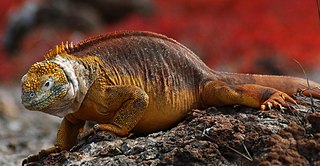
Homonota is a genus of South American geckos, commonly known as marked geckos.

The Galápagos land iguanas comprise the genus Conolophus of the Galápagos Islands (Ecuador). The number of species of this variable genus has always been disputed; the most current taxonomic surveys suggest that three species exist:

The Gran Chaco or Dry Chaco is a sparsely populated, hot and semiarid lowland natural region of the Río de la Plata basin, divided among eastern Bolivia, western Paraguay, northern Argentina, and a portion of the Brazilian states of Mato Grosso and Mato Grosso do Sul, where it is connected with the Pantanal region. This land is sometimes called the Chaco Plain.

The Domus Sanctae Marthae is a building adjacent to St. Peter's Basilica in Vatican City. Completed in 1996, during the pontificate of Pope John Paul II, it is named after Martha of Bethany, who was a sibling to Mary and Lazarus of Bethany. The building functions as a guest house for clergy having business with the Holy See, and as the temporary residence of members of the College of Cardinals while participating in a papal conclave to elect a new pope.
George Sprague Myers was an American ichthyologist who spent most of his career at Stanford University. He served as the editor of Stanford Ichthyological Bulletin as well as president of the American Society of Ichthyologists and Herpetologists. Myers was also head of the Division of Fishes at the United States National Museum, and held a position as an ichthyologist for the United States Fish and Wildlife Service. He was also an advisor in fisheries and ichthyology to the Brazilian Government.

The Galápagos land iguana is a species of lizard in the family Iguanidae. It is one of three species of the genus Conolophus. It is endemic to the Galápagos Islands (Ecuador), in the dry lowlands of Fernandina, Isabela, Santa Cruz, North Seymour, Baltra, and South Plaza Islands.

Conolophus marthae, the Galápagos pink land iguana, is a species of lizard of the family Iguanidae. This critically endangered iguana is native only to the Wolf Volcano in northern Isabela Island of the Galápagos (Ecuador). It has a pink body with some dark stripes, prompting some to call it the pink iguana or the Galápagos rosy iguana. The species was first discovered in 1986 and was identified as a separate species, distinct from the Galápagos land iguana, early in 2009. This species is the only example of ancient diversification in the genus Conolophus and is one of the oldest events of divergence ever recorded in the Galápagos.
Pholiota marthae is a species of agaric fungus in the family Strophariaceae. Found in Argentina, it was described as new to science by mycologist Rolf Singer in 1969.
Phaea marthae is a species of beetle in the family Cerambycidae. It was described by Chemsak in 1977. It is known to be from Mexico.

Homonota fasciata, also known as the South American marked gecko, is a nocturnal species of gecko. It lives in Bolivia, and in Argentina. It is found in tropical deciduous forest and desert scrub habitats. It feeds on insects.
Alfredo Borelli was a French-born Italian zoologist, who worked mainly in Turin but who, early in his natural history career, conducted field work in South America.
Borelli's marked gecko is a species of gecko. It lives in Argentina and Paraguay.

Homonota darwinii, also known as Darwin's marked gecko or prickly gecko, is a species of gecko. It is endemic to Argentina.

Homonota horrida, also known as South American marked gecko, is a species of gecko. It lives in Argentina and Paraguay.
There are two species of gecko named South American marked gecko:
Homonota rupicola is a species of gecko. It is endemic to Paraguay.
Homonota taragui is a species of gecko. It is endemic to Argentina.
Homonota underwoodi is a species of gecko, a lizard in the family Phyllodactylidae. The species is endemic to Argentina.
The Argentine marked gecko is a species of lizard in the family Phyllodactylidae. The species is endemic to Argentina.
Homonota williamsii is a species of gecko. It is endemic to Argentina.








